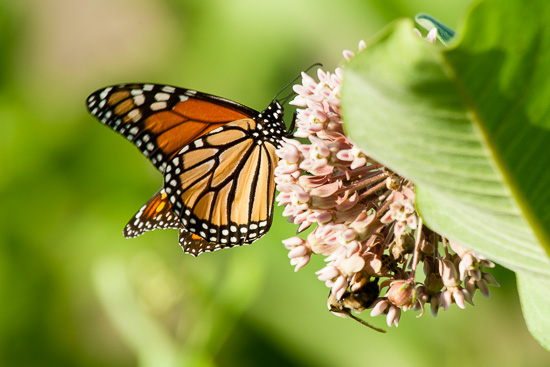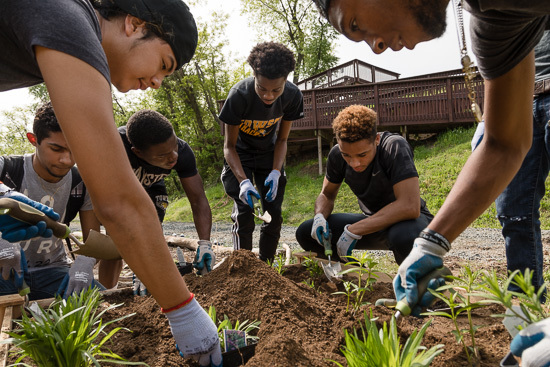Monarchs and communities share common ground
Creating habitat for the imperiled butterfly is boosting urban green spaces in Baltimore
At many points on its famously long eastern migration route from central Mexico to Canada, the monarch butterfly faces the perils of habitat loss. As a result, its population has declined by over 90 percent since the 1990s. Efforts to save the striking orange insect range from the unique forests of the Monarch Butterfly Biosphere Reserve in Michoacàn to the “Monarch Highway” in the Midwest—and all the way to the urban communities of South Baltimore.
For many city residents of neighborhoods like Brooklyn and Curtis Bay, the monarch was already effectively gone. But with funding from the National Fish and Wildlife Foundation (NFWF) through a Five Star Urban Waters Grant, the Monarch Butterfly Community Conservation Program began last fall with the goal to engage hundreds of volunteers, students and Baltimore community members in the planting of habitat for the butterfly. The program builds on existing efforts by partnering organizations to reconnect communities with their green spaces.

“The National Wildlife Federation and the National Aquarium have been working in communities around Baltimore for quite some time, creating native habitat through residential gardens and church gardens and community gardens,” said Gabrielle Roffe, conservation community coordinator at the National Aquarium. “This grant program was sort of a natural progression, to engage more open community spaces in schools.”
Roffe said that creating native habitat for the monarchs would help connect local residents with an international conservation issue.
“What we’re working to do is create a full-fledged education program to really empower the students to take ownership of these green spaces and understand the ‘why’ behind these gardens,” Roffe said.
The program began last August on an island in the Chesapeake Bay that might have disappeared beneath the water had its own decline not been reversed. Poplar Island—shrunk like other Chesapeake islands by the forces of sea level rise, sinking land and increasingly frequent strong storms before being restored to its historical footprint—now supports large patches of common milkweed, the primary host plant of the monarch. Partners from National Aquarium and Living Classrooms Foundation harvested the seeds along with staff from the U.S. Fish and Wildlife Service.
This spring, the milkweed seeds got a head start in a new greenhouse at Masonville Cove Environmental Education Center in Baltimore, being grown with help from the Living Classrooms Foundation. The National Park Service also partnered with the program to plant some of the monarch gardens on their lands, such as at Fort McHenry National Monument.
“Then the National Wildlife Federation and the National Aquarium, we are the partners who are on the ground in the community, running the education programs and planting the gardens with the community members and the schools,” Roffe said.
In April, students from Benjamin Franklin High School in the nearby neighborhood of Brooklyn gathered at the Masonville Cove greenhouse for the first planting under the program. Roffe showed them how to remove the plants from their containers and use trowels to work them into raised beds. Digging alongside the students was their science teacher, Hillary Clayton.

“Masonville Cove has been an unbelievable resource for my classes and fantastic for my kids to experience,” Clayton said.
Once neglected and laden with trash and toxic chemicals, Masonville Cove’s 54 acres of land and 70 acres of water now support an array of wildlife, including wetlands, an osprey nest, an artificial oyster reef and a native meadow.
“You can say it a million times in a classroom but they don’t really understand it until they come out here and see it. It’s just been really powerful for them,” Clayton said. “They can see exactly what their actions do and what kind of things they can prevent.”
Clayton grew additional native plants in lush trays beneath glowing lamps in her classroom earlier this year. The school was one of several to plant a habitat garden under the program. Though the gardens are still young, previous plantings suggest what Benjamin Franklin and the other schools can expect from their new gardens.
“When you build it, they will come. We’ve planted a lot of gardens in local urban communities and seen that once you start planting, local species start coming back,” Roffe said. “We’ve gotten calls from residents, saying, ‘The monarchs are here! The monarchs are here!’”
Roffe understands the experiences are special because of where they’re taking place.
“The joy on their faces is just really incredible because people are dealing with a lot on a daily basis, especially in these neighborhoods,” Roffe said. “Knowing that they have had a contribution to bring such an iconic species back into Brooklyn and Curtis Bay and other neighborhoods that they haven’t seen these species in who knows how many years—that’s where you really see the biggest impact.”
To view more photos, visit the Chesapeake Bay Program Flickr page.

Comments
There are no comments.
Thank you!
Your comment has been received. Before it can be published, the comment will be reviewed by our team to ensure it adheres with our rules of engagement.
Back to recent stories